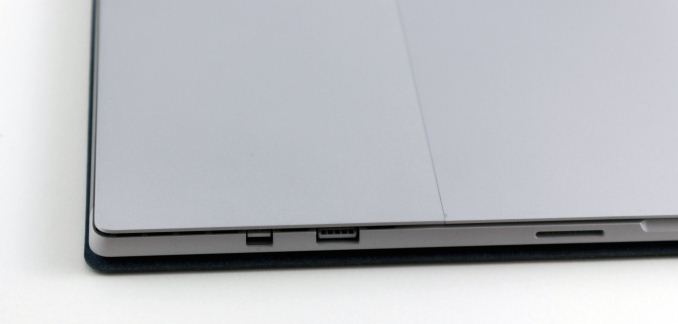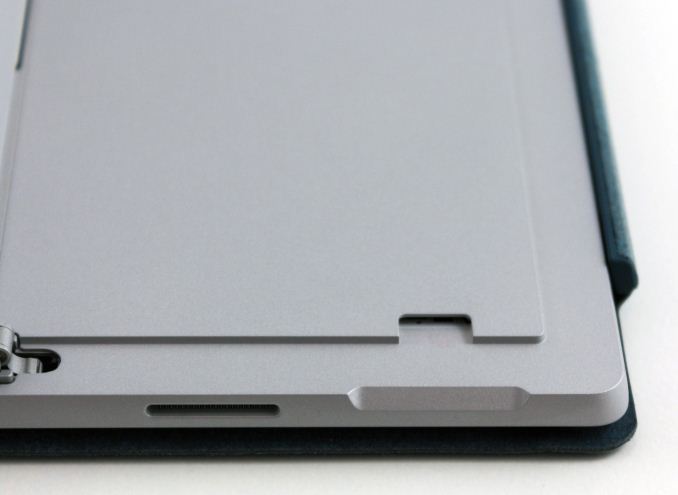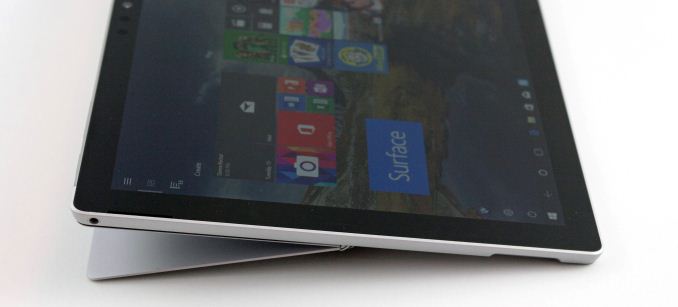The Microsoft Surface Pro (2017) Review: Evolution
by Brett Howse on June 15, 2017 9:00 AM ESTDesign
The Surface Pro 3 brought about a revolution in the design of the Surface Pro family, bringing the 3:2 aspect ratio that is now the signature on all Surface devices, as well as a much thinner and lighter design. Surface Pro 4 evolved that design, bringing a slightly larger display into the same size chassis, while becoming a bit thinner and lighter again. The new Surface Pro continues that evolution-rather-than-revolution philosophy, and that’s arguably the right choice for a successful product.
The latest design has softened the exterior, moving away from the angular design that has been a part of Surface Pro since the beginning. The edges are now slightly rounded, but without radically changing the look. The new rounded sides provide an improved in-hand feel, without the uncomfortable sharpness of the older generations.
The design is familiar though, with the same silver color on the chassis, along with a thin plastic RF window at the top, where the power and volume controls are. The left-side features the 3.5 mm headset jack, the right-side features all of the ports, and the bottom has the keyboard connector.
Speaking of the ports, they are exactly the same as the Surface Pro 4. There’s a USB-A port, a mini DisplayPort, and the Surface Connect for power and expansion. For those that need to add a bit more storage, the new Surface Pro continues to offer a micro SD slot too.
The lack of USB-C with Thunderbolt 3 in a high-end 2017 device is definitely a knock against the new Surface Pro. Microsoft’s reasoning is that USB-C is a port with too many options, and no two ports are guaranteed to be the same, which will lead to customer confusion. There’s also the argument that most of our devices still use full-sized USB, so Microsoft has stuck to its guns and just kept the USB-A port. They aren’t wrong about USB-C being confusing, though. Other than USB data, which is the one thing that all USB-C should support – although not always at the same speed – ports can support displays, higher power levels, Thunderbolt 3, and more. The counterpoint to this argument is that Surface Pro could offer a USB-C that features everything, although it would cost not only in terms of actual cost, but also space for extra chips, and in a small device like the Surface Pro, space is at a premium.
Their other argument is that, at least currently, almost anything that connects to USB-C needs an adapter or dongle of some sort, and that’s also true. But the counter to that is that the Surface Pro features a mini DisplayPort, which arguably needs a dongle or special cable to connect to almost anything anyway. A USB-C could offer the same DisplayPort signal, but way more.
There’s no argument that keeping the USB-A port is the right idea for today, but it would have been nice to see Microsoft adopt the new standard for the future, since a device with this kind of price has to have the expectation that it will still be around in several years, when USB-C will be more widespread.
The Kickstand
The one area that Microsoft both pioneered – and continued to evolve – is the kickstand. Looking back at the original Surface devices, the kickstand really the key to the entire device, allowing Surface to quickly and easily be used as both a tablet, and a laptop. The latest kickstand improves everything, again.
The biggest change is that the kickstand now opens even wider. The opening arc increases from 150° to 165°, which gives the Surface Pro an even better platform for using the Surface Pen, and accessories like the Surface Dial, which works right on the display, just like the Surface Studio.
The new kickstand seems to be even smoother than the Pro 4, and still offers just the right amount of friction to not allow the Pro to change angles when using touch on the display.
The kickstand is still one of the signature features of the Surface Pro, and it’s great to see it continue to improve.
Cooling Upgrades
The Surface Pro 4’s cooling was a big improvement over the Surface Pro 3, greatly reducing CPU thermal throttling, but also being quieter. The new Surface Pro develops on this again. When the Surface Pro 4 launched, the engineers let us know that they felt that the cooling system could dissipate the full 15-Watts of heat from the CPU passively, but they still included the fan on both the Core i5 and Core i7 models for the Surface Pro 4.
The new Surface Pro ditches the fan completely on the (15W) Core i5 model now, leaving just the (15W) Core i7 model with active cooling. Microsoft hasn't yet sampled this model of the Surface Pro, but hopefully we’ll be able to test it out soon to see what ramifications that changes has for performance. For noise though, it’s all good news, since it should be practically silent.
The Core i7 model, that we do have for review, is even quieter than the outgoing Pro 4, especially when at its default settings. So despite the active fan, the cooling system is much quieter. The cooling vents have been changed as well, with a much more subtle look to them on the new Pro.
The cooling changes have all been positive, and we’ll check out the performance of them later in the review.













124 Comments
View All Comments
North01 - Thursday, June 15, 2017 - link
Great review! Hopefully you can also review the i5 model, or at least comment on the performance of their new fanless design. While I've been hearing positive things, I would really like to know how it throttles when dealing with a heavy workload.id4andrei - Thursday, June 15, 2017 - link
Only the Verge so far has received an i5 model and according to the reviewer it supposedly gets better battery life. The i7 allegedly suffers a 20% drop in battery life.ryan.bunce - Thursday, June 15, 2017 - link
The previous Surface Pros were unable to drive dual 4K screens at 60Hz. Did you happen to test the new one with two 4K screens?MattMe - Thursday, June 15, 2017 - link
This I did not know. Do you mean with the external Surface (4) dock?I'm sure I'd seen shots of people doing that. I've very sure I've seen it with the Surface Book, and that uses the same CPU SKUs at the Pro 4.
ryan.bunce - Thursday, June 15, 2017 - link
Yes with the dock, but also if you daisy chain the monitors together. Here's a couple of articles from folks who've noted it:http://tiamat.tsotech.com/surface-book-incapable-o...
https://www.petri.com/run-two-4k-monitors-surface
Brett Howse - Thursday, June 15, 2017 - link
This is a limitation of the Intel GPU. It only provides DisplayPort 1.2 streams, so you can only connect one UHD/60Hz display per stream. There are two though, since you can connect one on the dock, and one on the device itself, so you can run 2 UHD/60Hz but the cabling is a bit silly.ryan.bunce - Friday, June 16, 2017 - link
So must be the two port on the SP4 Dock are just daisy chained on the same channel. Makes sense - all the more reason why a thunderbolt port on the SP would be great.soliloquist - Thursday, June 15, 2017 - link
I always wanted to see a detailed thermal/throttling test between the i5 and the i7 on the SP4 and would be even more interesting with the 2017 SP (since the i5 is fanless).Really wish you would have run the thermal test a little longer. In your original SP4 tests you really didn't see the thermal limits reached until around 25 mins (which is when you stopped testing this time).
http://www.anandtech.com/show/9727/the-microsoft-s...
From this article you say "The Iris does allow a lot more graphics potential, but for longer duration requirements, it may not offer much of an upgrade."
This is what I would really like to see examined. Is the extra money for the i7 really worth it, particularly when longer durations are taken into account.
Thanks for the great write up otherwise.
Brett Howse - Thursday, June 15, 2017 - link
I'll run a longer test and let you know how I make out. The temperatures were stable though so it *should* be the same, but I can try this and let you know.soliloquist - Friday, June 16, 2017 - link
Thanks. Will look for it!